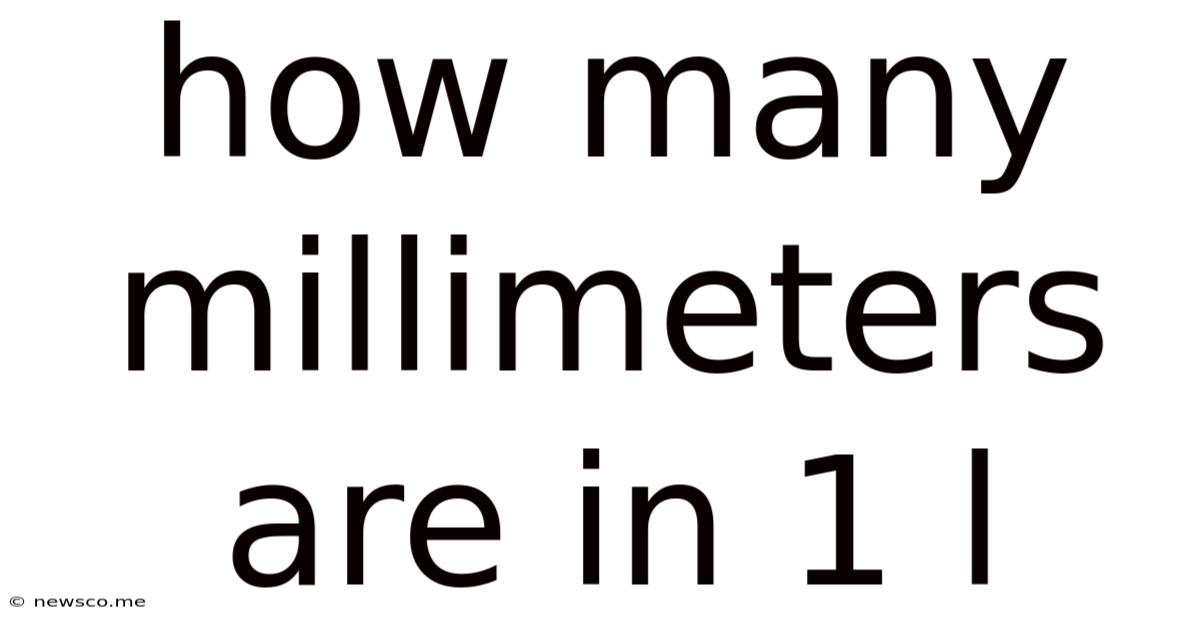How Many Millimeters Are In 1 L
News Co
Apr 15, 2025 · 4 min read

Table of Contents
How Many Millimeters Are in 1 Liter? Understanding Units of Measurement
The question "How many millimeters are in 1 liter?" is a bit of a trick question, highlighting the crucial difference between units of volume (liters) and units of length (millimeters). They are not directly convertible; it's like asking how many apples are in an orange – they measure different things. However, we can explore the relationship between volume and length, especially when dealing with specific shapes like cubes or rectangular prisms. This article delves into the intricacies of units of measurement, focusing on liters and millimeters, and explores how they relate when considering cubic dimensions.
Understanding Liters and Millimeters
Let's first define our terms clearly:
-
Liter (L): A unit of volume in the metric system. It's a measure of how much space a substance occupies. One liter is equivalent to 1000 cubic centimeters (cm³).
-
Millimeter (mm): A unit of length in the metric system. It's one-thousandth of a meter (1/1000 m). It measures distance or length.
The fundamental difference is that liters measure volume, a three-dimensional quantity, while millimeters measure length, a one-dimensional quantity. You can't directly convert one to the other without additional information about the shape of the container holding the liquid.
The Connection Through Cubic Millimeters
To understand how liters and millimeters relate, we need to introduce cubic millimeters (mm³). A cubic millimeter is a cube with sides of 1 millimeter each. This is a unit of volume. We can convert liters to cubic millimeters, and then we can relate this volume to the linear dimensions (in mm) of a container.
Conversion:
1 liter = 1,000,000 cubic millimeters (mm³)
This conversion arises from the following relationships:
- 1 liter = 1000 cubic centimeters (cm³)
- 1 cm = 10 mm
- 1 cm³ = (10 mm)³ = 1000 mm³
- Therefore, 1 liter = 1000 cm³ * 1000 mm³/cm³ = 1,000,000 mm³
Calculating Dimensions from Volume: Examples
Now let's consider how this volume relates to linear dimensions. The calculations depend heavily on the shape of the container.
Example 1: A Cubic Container
Imagine a perfect cube filled with 1 liter of liquid. To find the length of one side (in millimeters), we need to find the cube root of the volume in cubic millimeters:
- Volume = 1,000,000 mm³
- Side length = ∛1,000,000 mm³ = 100 mm
Therefore, a cube containing 1 liter would have sides of 100 mm each.
Example 2: A Rectangular Prism Container
Let's consider a rectangular prism (a box) holding 1 liter. If we know the length and width, we can calculate the height. For example:
- Volume = 1,000,000 mm³
- Length = 200 mm
- Width = 100 mm
Height = Volume / (Length * Width) = 1,000,000 mm³ / (200 mm * 100 mm) = 50 mm
The height of this rectangular prism would be 50 mm.
Example 3: A Cylindrical Container
Cylindrical containers introduce another dimension: radius (r) and height (h). The volume of a cylinder is given by the formula: V = πr²h
If we know the radius, we can calculate the height:
- Volume = 1,000,000 mm³
- Radius = 50 mm
Height = Volume / (πr²) = 1,000,000 mm³ / (π * (50 mm)²) ≈ 127.3 mm
Importance of Shape and Practical Applications
These examples clearly demonstrate that simply knowing the volume (1 liter) is insufficient to determine the linear dimensions (in millimeters). The shape of the container plays a crucial role. This is relevant in many practical situations:
-
Packaging Design: Manufacturers need to calculate the dimensions of containers to hold a specific volume of product. This involves careful consideration of the desired shape (cube, cylinder, etc.) and material costs.
-
Fluid Dynamics: In engineering, understanding the relationship between volume and the dimensions of pipes or channels is vital for calculating fluid flow rates and pressures.
-
Medical Applications: Precise measurements are essential in medical fields, particularly in drug dosage and delivery systems.
-
Construction and Architecture: The calculation of volumes and dimensions is vital in determining material requirements and structural integrity for buildings and other structures.
Beyond Simple Shapes: Irregular Volumes
For containers with irregular shapes, calculating the relationship between liters and millimeters becomes significantly more complex. Advanced techniques like calculus (integration) or numerical methods are usually required to determine the volume and subsequently relate it to linear dimensions.
Conclusion: A Critical Distinction
While liters and millimeters are both part of the metric system, they measure fundamentally different aspects of a substance. Liters measure volume, while millimeters measure length. Direct conversion between the two is impossible without knowing the shape of the container holding the liquid. However, understanding cubic millimeters provides a bridge for relating these units, allowing us to calculate linear dimensions based on volume, particularly for simple geometric shapes. The ability to perform these conversions is essential in various fields, highlighting the importance of grasping the fundamental differences between units of measurement and their interrelationships. For irregularly shaped containers, more sophisticated techniques are necessary to relate volume and linear dimensions.
Latest Posts
Related Post
Thank you for visiting our website which covers about How Many Millimeters Are In 1 L . We hope the information provided has been useful to you. Feel free to contact us if you have any questions or need further assistance. See you next time and don't miss to bookmark.